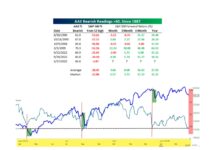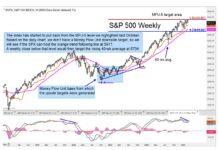 By Greg Naylor February was an eventful month, as the U.S. government struggled unsuccessfully to avoid ‘sequestration,’ and Italy held elections with possible ramifications for the euro zone. Cash continued to flow back into the U.S. stock market. Here is a re-cap of February by the numbers:
By Greg Naylor February was an eventful month, as the U.S. government struggled unsuccessfully to avoid ‘sequestration,’ and Italy held elections with possible ramifications for the euro zone. Cash continued to flow back into the U.S. stock market. Here is a re-cap of February by the numbers:
Stocks & Bonds
The American stock market continued its strong start to the year, although some international stocks posted losses. Bonds reversed course after a negative January.
| S&P 500 Total Return | MSCI EAFE | BarclaysAggregateBond | Unadjusted CPI | |
| February | 1.36% | -0.95% | 0.50% | 0.29% |
| January | 5.18% | 5.27% | -0.70% | -0.27% |
| YTD 2013 | 6.60% | 4.27% | -0.20% | 0.03% |
Commodities & Currencies
NYMEX Crude declined 5.7% in February. Most other commodities also posted declines for the month. Gold declined 5.0%, continuing its multi-month losing streak.
The Dollar Index rose 3.46% in February, on the back of strong gains in January. The Yen and Euro continued to see pressure for political reasons, Japan with its new monetary easing, and Europe with elections in its 3rd-largest economy of Italy. The Italian elections were unable to determine a clear winner, making it probable that another round of elections would be necessary later this year. Markets do not like any kind of uncertainty, and so this lack of progress has pressured the euro.
Economy
Economic indicators offered some good news in February. The Institute for Supply Management reported that the manufacturing PMI in February rose to 54.2, indicating continued expansion. Also, the Commerce Department issued a revised report for 4th quarter GDP. Rather than contracting by 0.1%, GDP actually grew by 0.1%.
The National Association of Realtors (NAR) reported that the annual rate of existing-home sales in January increased by 9.1% from January 2012. National median prices rose in January from the prior year by 12.3% to $173,600. Foreclosures and short sales continue to shrink as a percentage of overall sales, although they remain higher than average.
Summary
Finally, after several years of selling, retail investors are just now beginning to buy stocks again. This bodes well for stock prices and the stock market if it continues. The deflationary effects of the sequestration will be battled by the inflationary strategy of Ben Bernanke and the Fed – they will likely fight each other to a draw.
This material was prepared by Greg Naylor, and does not necessarily represent the views of Woodbury Financial or its affiliates. This information should not be construed as investment, tax or legal advice and may not be relied upon for the purpose of avoiding any Federal tax liability. This is not a solicitation or recommendation to purchase or sell any investment or insurance product or service, and should not be relied upon as such. The S&P500, MSCI EAFE and Barclays Aggregate Bond Index are indexes. It is not possible to invest directly in an index.
Investing involves risks and investors may incur a profit or a loss. Past performance is not an indication of future results.
Data Sources:
- www.standardandpoors.com – S&P 500 information
- www.msci.com – MSCI EAFE information
- www.barcap.com – Barclays Aggregate Bond information
- www.cmegroup.com – NYMEX crude prices
- www.bloomberg.com – U.S. Dollar & commodities performance
- www.realtor.org – Housing market data
- www.bea.gov – GDP numbers
- www.bls.gov – CPI and unemployment numbers
- www.commerce.gov – Consumer spending data
- www.napm.org – PMI numbers
- www.coinnews.net – Gold and silver price information
About Greg Naylor: Greg is a partner and co-founder of Fiat Wealth Management, an independent financial advisory firm in Long Lake, Minnesota. He has been investing for over 7 years and enjoys sports, reading, singing, and spending time with family. Greg is a 2004 graduate of the University of Minnesota and lives in South Minneapolis with his wife Kat. Click here for more articles by Greg.
Twitter: @seeitmarket Facebook: See It Market








